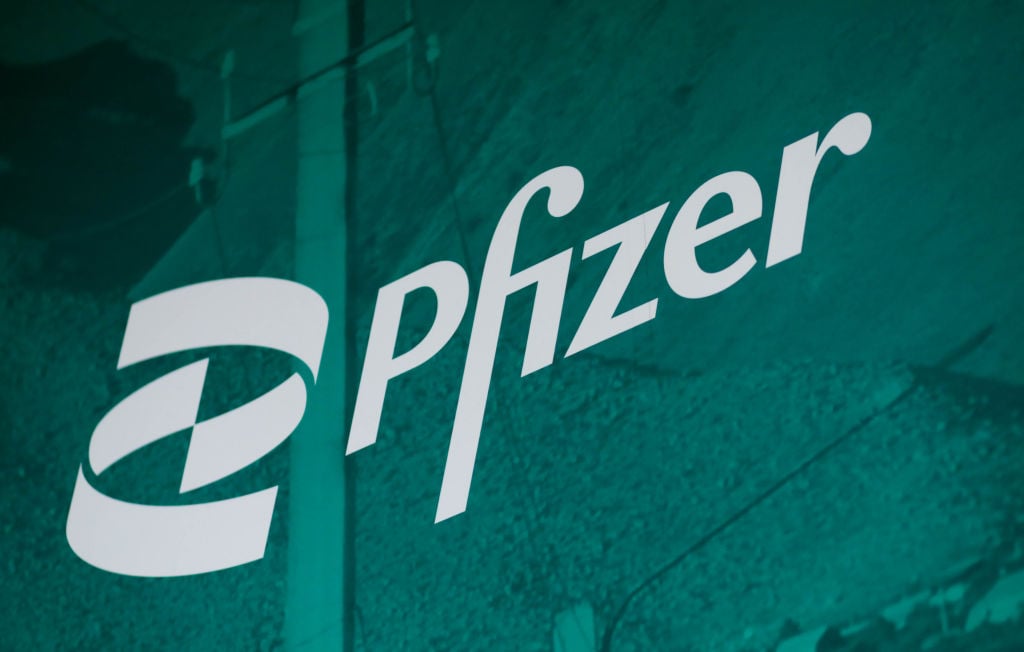You know there was some bad news with a company's quarterly update when the stock drops after the results are announced. That's what happened Tuesday morning with Pfizer (PFE 0.82%). The big pharma company's shares fell more than 3% in premarket trading after the announcement of its Q4 results before the market opened.
But you also know there's some good news for a company in a quarterly update when the stock moves higher in early trading. And that's also what happened for Pfizer on Tuesday morning, with shares climbing more than 2%.
What was Pfizer's good news and bad news? Here are four key things you need to know from the drugmaker's Q4 earnings update.

Image source: Pfizer.
1. Disappointing 2019 outlook
The main reason why Pfizer's share price slipped in premarket trading on Tuesday morning had nothing to do with the company's fourth-quarter performance. Instead, it related to what Pfizer had to say about what will happen in 2019.
Pfizer provided guidance for full-year 2019 that clearly disappointed investors. The company expects revenue between $52 and $54 billion. Pfizer also projects that adjusted earnings per share (EPS) will be between $2.82 and $2.92. The company's 2019 outlook reflects minimal to no growth over 2018.
Wall Street analysts were expecting a stronger performance. The consensus forecast for 2019 revenue was $54.36 billion, while analysts estimated adjusted EPS would be around $3.04.
Pfizer CFO Frank D'Amelio said that the 2019 guidance reflects "an anticipated $2.6 billion revenue headwind due to products that have recently lost or are expected to soon lose marketing exclusivity." Viagra is the product that recently lost marketing exclusivity, and Pfizer loses exclusivity for Lyrica this summer.
2. A pretty good Q4 overall
While Pfizer provided weaker-than-expected 2019 guidance, the company also reported pretty good overall 2018 Q4 results. Pfizer announced Q4 revenue of $14 billion, up 2% year over year and a little higher than the Wall Street estimate of $13.91 billion.
The company also posted Q4 adjusted EPS of $0.64. This reflected a year-over-year increase of 3%. It also narrowly beat the average analysts' estimate of $0.63.
I had predicted a few days ago that Pfizer could take a bigger hit from foreign exchange fluctuations in the fourth quarter than it did in Q3. That appeared to be the case. The company stated that reported revenue was 3% lower because of the unfavorable impact of foreign exchange.
3. Strong performance from key blockbusters
Pfizer continued to benefit from a strong performance from several of its key blockbusters. The biggest winner was breast cancer drug Ibrance, with sales soaring 58% year over year to $1.13 billion due to impressive growth in international markets.
Anticoagulant Eliquis, which Pfizer co-markets with Bristol-Myers Squibb, also kept up its winning ways with sales of $910 million, a 28% year-over-year increase. Xeljanz enjoyed another great quarter as well. Sales for the immunology drug jumped 35% over the prior-year period to $553 million.
The biggest question marks for the fourth quarter were how well Pfizer's top two products, Prevnar 13 and Lyrica, would fare. Sales for Prevnar 13 fell 1% year over year to $1.51 billion. However, Q3 sales for the pneumococcal vaccine were boosted by timing of purchases by the U.S. government, so a slight dip in Q4 was expected. On the other hand, sales for the innovative health segment's Lyrica product increased 8% over the prior-year period to $1.22 billion.
The only blockbusters other than Prevnar 13 to see sales slide in Q4 were Enbrel and Sutent. Both drugs continue to face increased competition.
4. Same old problems persist
In Pfizer's Q2 earnings conference call, then-CEO Ian Read stated that the company expected to see year-over-year improvement for the sterile injectables business beginning in the third quarter of 2018. That improvement didn't materialize in Q3. And the same problems persisted in Q4.
Sterile injectables pharmaceuticals revenue fell 8% year over year in the fourth quarter to $1.29 billion. Pfizer attributed the sales decline to increased competition and the continued product shortages in the U.S.
Looking ahead
As Pfizer's 2019 guidance hinted, this year will be a period in which Pfizer takes one step forward and one step backward. Top drugs including Ibrance and Eliquis will continue to perform well. However, the loss of U.S. exclusivity for Lyrica will take a serious toll on Pfizer's top and bottom lines later this year.
But Pfizer's future beyond 2020 continues to look very bright. The company just announced positive results from a phase 3 study of pain drug tanezumab and expects to soon report results from a pivotal late-stage study of the drug. Pfizer's pipeline also includes several other promising candidates. Once the company moves past the impact of loss of exclusivity for Lyrica, Pfizer should deliver a lot more good news than bad news for investors.
Check out the latest Pfizer earnings call transcript.






